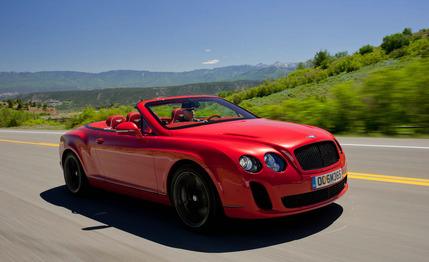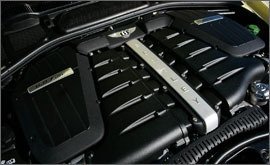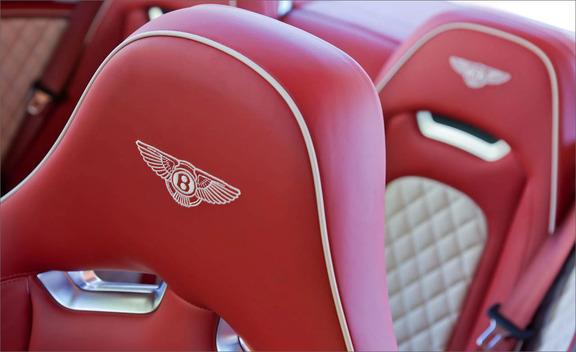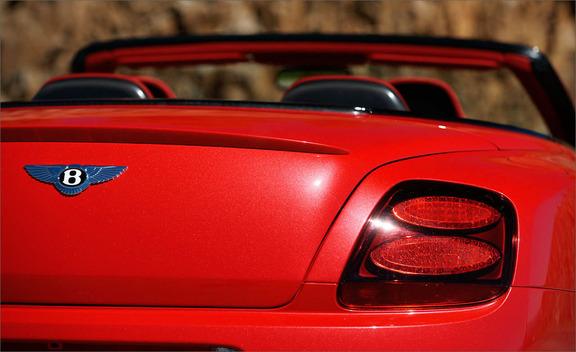 First Drive Review
First Drive Review
Everybody knows that sports are contests of skill in which a winner emerges, but what are supersports? Judging from the Bentley Supersports, which pairs the automaker’s expected refinement and elegance with supercollider acceleration and centrifugal corner stickiness, Supersports are something altogether more strange, like a mixture of various sports. Think WhirlyBall, which mixes bumper cars with elements of jai alai and basketball; or paintball, which mixes participants shooting one another with not dying.
Bentley already has superhero-level Continentals in the family—the Speed versions of the GT, Flying Spur, and GTC—but the Supersports models are more thoroughly changed beasts. This particular one takes the Bentley Continental GTC (GT convertible), strips out nearly 200 pounds, drops the suspension 0.4 inch and stiffens it by up to 33 percent, and wrings another 21 hp out of the 6.0-liter W-12 engine. Weight primarily comes out of the seats, brakes, and wheels. At 5400 or so pounds, it’s still hardly light, but 621 hp does a fine job of overcoming the mass. Bentley claims 0 to 60 mph should take 3.9 seconds, and given the quickest time we’ve wrung out of a Continental GTC Speed is 4.3 seconds, that sounds pretty close. Shifts from the six-speed ZF gearbox are quickened—you can hear how quick they are on the Supersports coupe in our weekly “Name That Exhaust Note” blog feature.
Supersonic Speeds, Super Easy
Like all members of the Continental family, this convertible is relaxed and tremendously composed at supersonic highway speeds. It’s just that it gets to those speeds more quickly and can maintain them through tighter turns and with greater composure. Although the push of 590 lb-ft of torque is never subtle, brief turbo lag and all-wheel drive mean the first half-second or so of this Bentley’s launch is a bit soft. Where it really impresses is at higher speeds, when the 621 hp batter aerodynamics into submission and the car continues to pull to ludicrous velocities. Bentley claims a top speed of 202 mph.

Anything weighing 5400 pounds and turning 20-inch, 275-width Pirellis at each corner is going to feel planted, but other GTCs tend toward understeer when the kinks tighten. Not the Supersports. Its torque split is tweaked from 50/50 front to rear to 40/60, balancing cornering behavior. For the first time in a Continental droptop, really hammering the throttle midcorner can induce some oversteer. Body roll is completely absent. Bentley chairman Franz-Josef Paefgen says the Supersports will turn a Nürburgring lap time similar to a Ferrari’s, but the accuracy of that statement depends on your definition of “similar.” Both are measured in minutes and seconds, but the Supersports time of about eight minutes 30 seconds isn’t going to worry anyone in Maranello.
Heavy cars at high speed need good brakes, and Bentley claims the carbon-ceramic units it fits to the Supersports are the most powerful binders currently fitted to any passenger car. At 16.5 inches up front, they are certainly supersized. Although the pedal feels spongy, the immediacy with which the brakes haul the car down from speed will have your ribcage feeling spongy as well. We measured a 157-foot stop from 70 mph in a Supersports coupe, and the convertible should be able to mimic that feat. Despite the superb braking performance, the driver’s best connection to the Continental Supersports is the steering wheel. Although not providing much in the way of feedback, it is nicely weighted, progressive, and wrapped in leather so fantastically grippy you can steer with your palms.
Superlative Trimmings
The cabin is swaddled in similar tactile treats, with Alcantara everywhere, including the carbon-fiber bucket seats. Manually adjustable thrones in a Bentley might seem appalling, but those seats are responsible for 90 pounds of the Supersports’s weight reduction. The coupe benefits further from the loss of its rear seats, but in the convertible, those seats house the rollover protection hoops. Even if Bentley had removed the cushions, the structure hidden in the headrests would still have to be there, so the engineers left the seats in.

On the outside, the Supersports convertible gets the same visual enhancements as the coupe: additional apertures in the front fascia and hood for better airflow, the sinister black wheels, and a lip on the rear fenders to cover the widened—by two inches—rear track. The net effect is menacing, an adjective not often employed in Bentley reviews. And with contrasting piping and quilting highlighting the Alcantara interior, the car looks as good from the inside as outside.
Super(fluous)sports?
Interestingly, the progression from Continental GT to GT Speed to Supersports seems to have overshot the sweet spot for huffy luxury marques, and its maker knows it. Bentley says fully 60 percent of Continental sales are now Speeds, which carry a $30,000 premium over non-Speed cars. Supersports sales have been somewhat slower; the company sold only 30 coupes last year and plans to import just 80 convertibles this year. That’s probably not so much a function of price—the Supersports adds about $50,000 on top of the Speed’s sticker, for a base price of $286,695—as it is a reaction to the altered character of what used to be essentially a private bullet train.

Although the Supersports is certainly capable, it does neither luxury nor sport as well as other $300,000 cars, and it’s highly unlikely someone spending this much on a car needs one vehicle to fill both of those roles. If you’re going to spend $300,000 on a luxury car, Bentley’s own Mulsanne is far more fabulous than the Supersports. If it’s a sports car you seek, the Italians have some fine vehicles for you. And if what you really want is something unexpected, that sum might also buy you your very own WhirlyBall arena.